Hungarian Notes and Coins
Hungarian money is one of the things you have to think about if you are coming to Budapest. If you’re thinking of sightseeing in Budapest(which I highly recommend!)this information will be very useful. Here’s a little ‘tell-all’ guide to introduce you to all the essential details, plus a few extra things we thought you’d just find interesting…
History of Hungarian Money
The name ‘forint’ originally comes from the city of Florence, where golden coins were minted from 1252 called ‘fiorino d’oro’. This gold-based currency was used in Hungary from 1325 under King Karoly Robert and is still the currency of Hungary today.
The forint was reintroduced in 1946 to help stabilize the post-WWII Hungarian economy, and it remained stable until the 1980’s and early 90’s, when transition to market economy devalued it and inflation peaked at 35%.
This has been an entirely different story since 2001, with inflation sticking to a single digit and the forint being declared fully convertible.
Interestingly, the forint is the only currency that was once used by a socialist European state that’s still in use, but this is set to change with the European Currency (the EURO) taking over every European State – including Hungary, and the forint is expected to be replaced entirely by 2018.
What Does Hungarian Money Look Like?
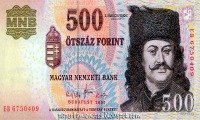 The 500 Ft – On the front is Prince II Rakoczy Ference, one of the bravest independence fighters ever known and leader of the Rakoczy uprising (1703-1711). He later became the prince of Transylvania. On the back is the Castle of Sárospatak, which was in the hands of the Rakoczi family and numerous other noble dynasties. Sárospatak is a town in northern Hungary, about 70 km away from Miskolc.
The 500 Ft – On the front is Prince II Rakoczy Ference, one of the bravest independence fighters ever known and leader of the Rakoczy uprising (1703-1711). He later became the prince of Transylvania. On the back is the Castle of Sárospatak, which was in the hands of the Rakoczi family and numerous other noble dynasties. Sárospatak is a town in northern Hungary, about 70 km away from Miskolc.
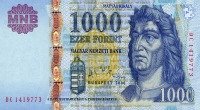 The 1000 Ft – On the front is King Matthias Corvinus (1458-1490), to whom Hungary owes it’s biggest extension. He’s an icon to the Hungarian people, with a church in Budapest named after him. On the back is the Hercules Fountain from the Castle of Visegrad -the summer castle of King Matyas.
The 1000 Ft – On the front is King Matthias Corvinus (1458-1490), to whom Hungary owes it’s biggest extension. He’s an icon to the Hungarian people, with a church in Budapest named after him. On the back is the Hercules Fountain from the Castle of Visegrad -the summer castle of King Matyas.
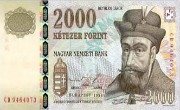 The 2000 Ft – On the front is Prince Gabor Bethlen on the front, and Prince Gabor Bethlen amongst his scientist on the back. Gabor Bethlen was a prince of Transylvania and a leader of an anti-Habsburg insurrection in the Habsburg Royal Hungary.
The 2000 Ft – On the front is Prince Gabor Bethlen on the front, and Prince Gabor Bethlen amongst his scientist on the back. Gabor Bethlen was a prince of Transylvania and a leader of an anti-Habsburg insurrection in the Habsburg Royal Hungary.
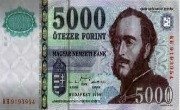 The 5000 Ft – On the front is Count Szechenyi Istvan, a Hungarian politician, theorist and writer and revered as one of the greatest diplomats in Hungarian History. On the back is the Szechenyi mansion in Nagycenk.
The 5000 Ft – On the front is Count Szechenyi Istvan, a Hungarian politician, theorist and writer and revered as one of the greatest diplomats in Hungarian History. On the back is the Szechenyi mansion in Nagycenk.
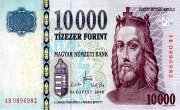 The 10000Ft – On the front is St Stephen, the first Christian king of Hungary. He established Christianity in the region and is considered to be the founder of the Hungarian nation. On the back is the view of Esztergom, hometown to king Stephen and home to the largest Basilica of Hungary.
The 10000Ft – On the front is St Stephen, the first Christian king of Hungary. He established Christianity in the region and is considered to be the founder of the Hungarian nation. On the back is the view of Esztergom, hometown to king Stephen and home to the largest Basilica of Hungary.
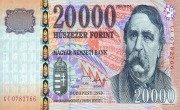 The 20000Ft – On the front is Ferenc Deák, a Hungarian statesman and Minister of Justice. He was known as “the wise man of the nation”. On the back is the old house of representatives in Pest.
The 20000Ft – On the front is Ferenc Deák, a Hungarian statesman and Minister of Justice. He was known as “the wise man of the nation”. On the back is the old house of representatives in Pest.
Exchanging Currency
Exchanging money in Hungary is easy, especially with ATM machines in every built-up area in Budapest. There are also currency exchange kiosks located in tourist areas and shopping malls which are highly recommended for ensuring you get the best exchange rates. Banks also offer currency exchange services but they charge a surcharge.
Northline tends to consistently offer the best exchange rates for Hungarian money in Budapest, with several locations to choose from. Their website, although is only in Hungarian has got a useful and easy to use currency converter on the left side of homepage.
There are other exchange offices such as Exclusive, Interchange and OTP Bank (National Savings Bank)all offer currency exchange services throughout the city too, and the best idea is to check their rates in their branches because most don’t put their rates online.
Ideally, most credit cards, like Visa, Master Card and American Express are accepted in most places, especially at hotels, shops and restaurants, which makes spending and traveling far easier if you can’t find a currency exchange store.
Whatever you decide to do, you’re sure to enjoy the culture in Budapest on every level, with the Hungarian money providing you with a historical connection to this great city.
Tipping in Hungary
Tipping is a very common practice in Hungary and not only you tip waiters but also hairdressers, taxi drivers and assistants at petrol stations.
At some restaurants the service fee is included in the bill, and it usually ranges between 10% and 15%. It is advisable to always check the bill before you pay, though.
Although, most restaurants do not include the service fee or tip in the bill, 10% of the total amount is normally expected by waiters. But in all cases it is up to the customer’s satisfaction to leave some tip.
Keep in mind that in Hungary you don’t really leave the tip on the table. Instead when you pay the bill, tell the waiter how much money you are paying in total (in case you want to leave some tip) or how much change you would like to get back.
Even if you are paying with credit card you are expected to leave some tip, just tell the waiter when he brings the card reader how much money you are paying in total.
Return from Hungarian Money to Budapest Discovery Guide Home Page


